Tag: watering
Are your trees getting enough water?
Watering tips from the Eugene Team
This July didn’t hesitate to remind us just how hot it can get in an Oregon summer, with five consecutive days with highs over 100° Fahrenheit. And while many of us are lucky to be able to find shelter from a heatwave, trees don’t have that same luxury. For young trees in particular, extreme heat can cause tremendous stress and threaten the trees’ survival.
“It’s around this time every year when we start getting a steady flow of concerns about the well-being of young trees,” says Eugene Director Erik Burke. “Trees can dry out in just a couple days in a heatwave. There are a lot of factors that go into it, including the species and the site conditions.”
Trees that are getting too much water or not enough water can show similar symptoms. Most notably, their leaves will start to brown and curl. In most instances that a tree is getting too much water, it’s because the resident has lawn irrigation systems. It’s more common that a tree is under-watered.
“It can be hard for people to apply enough water,” Erik says. “Sometimes I see people misting the ground beneath their tree with a hose and then walking away. And there wasn’t even enough water to penetrate the soil.”
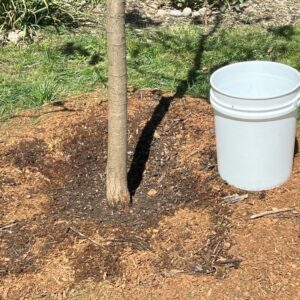
Trees need deep weekly watering during hot dry summer months: 10 to 15 gallons of water around the base of the tree. It’s important to imagine where the roots are. You want the water to be reaching through the soil to the ends of those roots. It’s also good practice to water in the morning or the evening when you’ll lose less moisture to evaporation. A thick layer of mulch will help retain moisture in the soil.
During a heatwave, your tree might need to be watered more often than once a week, but how do you know if it’s time to water? You can test the soil! There are inexpensive soil moisture readers available at hardware stores, or you can use something you have readily on hand, like a pencil or a stick.
“It’s like testing a cake to see if it’s done,” says Taylor Glass, our Eugene Springfield Program Manager. Insert your pencil several inches into the soil. When you pull it back up, if soil has stuck to the pencil then it still has moisture and you don’t need to water just yet. If it comes up dry you can go ahead and water your trees. Different soil types will dry out faster than others, so it’s important to check regularly and get to know your tree’s particular site.
“Some trees will suddenly torch, that is, get really dry and stressed,” Erik says. “As soon as you see that, you just want to water the heck out of it. Every species has a different tipping point.”
Some species like the Oregon ash or California buckeye will call it quits for the year when the soil gets dried out in August and just drop their leaves. When they come back next year they’re totally fine. But other trees won’t survive.
To help new tree owners take care of their trees, Friends of Trees sends out volunteer summer inspectors. For the first three summers of a tree’s life it will get two visits. The inspector will check on the tree’s well-being, look for any issues or concerns, and check the soil to see if there’s enough moisture.
“It’s a really fun role,” Taylor says.” You get to learn about trees while walking or biking around your neighborhood.”
With heat waves becoming more and more common, we need trees and the shade they provide to keep us cool. We need to return the favor and make sure we take care of trees so that they can survive and thrive.
Leaflet: Watering
Determining Your Tree’s Watering Needs
We’ve had a wet April, which means your trees are getting plenty of water! But the transition from spring to summer can be a tricky time to determine when to water your tree. Come this time of year, we recommend watering once a week when the weekly rainfall is less than one inch. But you might find yourself wondering, “when did it rain last?” (You can check here!)
Too much watering is the most common mistake, but consistent watering is crucial to getting these young trees established. A good way to know if your tree needs water is to check the soil. Stick a garden trowel or even a pencil 2-3 inches into the soil. If the soil at that depth is dry to the touch, then your tree is ready to be watered.

Once the dry season settles in, watering once a week is a good schedule (pick a day to water and keep it up!). Deep watering is best for these newly planted trees. Give 10-15 gallons at a time. Water slowly so that moisture soaks deeply into the soil and water doesn’t run away from the root zone. Mulching is a great way to hold water in the soil for your new trees.
“I always say that roots are infamously “lazy” and grow in response to mild stress, just like human muscle,” says Neighborhood Trees Senior Specialist Andrew Land. “We lift weights to encourage human muscle growth, whereas we water deeply and hold off for a week to encourage roots to follow that water downward, which helps establish sinker roots to fend off future drought.”
Trees and perennials have more vast root systems that hold up for the long haul, and they need deep and infrequent watering. Flowers and annuals need more daily and superficial watering, which just doesn’t work for a tree. Tree roots are growing 12-18″ down and just don’t get enough benefit from daily irrigation that is intended to water lawns.
Either a gator bag, hose on a gentle trickle for maybe 20 minutes, or a 5-gallon bucket with three 1/8″ holes drilled on the side at the bottom and filled 2-3 times consecutively works great. It’s a good practice to move the bucket around the tree each time you fill it to ensure that the whole root system gets water. Think of it this way: we’re trying to simulate a rain storm, during which all parts of the root system will get water at about the same time and rate.
It’s important to note that dry and hot are two different things. In late spring and early summer, we may get some seemingly perfect weather, and you don’t think to water your tree because it isn’t hot outside. But regardless of temperature, a dry spell is characterized as 2-3 weeks without significant rainfall. It might not be hot out, but your tree still needs a drink!
If the temperature gets over 90 degrees, bump your watering schedule up to twice a week. If we see another heat “event” coming, a good, deep soak beforehand can help the tree survive.
Leaflet: Spring Tree Care
Spring has Sprung – What that means for your trees
Spring has truly come in fits and starts this year. Some of us might still feel like it’s winter, and some are ready to announce that Spring has sprung! Trees are the same way when it comes to breaking dormancy. Some are early risers, and some sleep in. A bunch of factors go into it, including species, daylight, and temperature.
Spring is the perfect time to notice seasonal cycles. The study of these periodic events in biological life cycles is called phenology. When does a tree go dormant, when do you start to see buds, how long is the growing season? We can see quite a range among species.
“Cornelian cherries normally bloom about this time of year,” says Neighborhood Trees Senior Specialist Andrew Land. “Whereas a few years back, someone approached me about an Oregon white oak that they thought was dead, until it finally broke bud in June.”
Andrew and other staff at Friends of Trees keep an eye on phenology as it particularly relates to survival. They take note of trends in trees’ responses to different stimuli like light and temperature, with the intent to prioritize the most climate adapted species.
Here are some things you can do to take care of your trees this time of year.
Mulch Madness
It’s a great time to refresh mulch as needed. The objective is to mulch the tips of the roots as they grow outward from the base of the trunk. They will grow into soil that’s moderate in temperature and contains moisture, factors that mulch will provide. Because the roots are growing outward, when you mulch trees in their second year in the ground, aim for more of a 4-5′ diameter ring of mulch, still 3” thick, about a foot from the base of the trunk.
You may have noticed that some trees hold their leaves through winter. They’re called marcescent leaves, and they are a sign of last season’s growth. You’ll see them on native oaks like Oregon white oak (Quercus garryana) and scarlet oaks (Quercus coccinea). Come spring time’s flush, these leaves will be shed to make room for new growth. You can use these leaves as mulch!
 Go easy on the pruning
Go easy on the pruning
It’s best to go easy with regard to pruning during “bud break.” This is when sap is rising up the tree, after having dropped to the roots in the fall. As the sap is rising, some trees (maples, for example) will “bleed” if pruned as sap is rising. It’s not harmful to the tree—that’s where maple syrup comes from, after all—but it can be disconcerting to see.
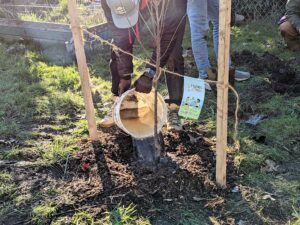
Weekly Watering
It’s almost time to start weekly watering for newly planted trees. “Deep and infrequent” is the recipe for success. Starting mid-April, 15 gallons all at once, once a week is ideal. Either a gator bag, hose on a gentle trickle for maybe 20 minutes, or a 5-gallon bucket with three 1/8″ holes drilled on the side at the bottom and filled 2-3 times consecutively works great.
If the temperature gets over 90 degrees, bump that up to twice a week. If we see another heat “event” coming, a good, deep soak beforehand is very wise as preventative medicine.
Leaflet – Watching the Seasons Change

You’re not the only one who’s noticing that the days are getting shorter. Our trees are noticing, too, and they’re taking it as a sign that the growing season is over. How do they notice? A hormone response is triggered by the shorter daylight hours, the angle of the sun, the cooler temps. This past month, you may have noticed a spring-like flush of herbaceous growth on your trees—one final push before autumn. That new growth will harden into woody material tough enough to survive our first frost in November.
Leaves on some deciduous trees will start changing color, a welcome sign of the cooler seasons after an especially hot summer. In a process called abscission, trees reabsorb the nutrients stored in the leaves before detaching and shedding them. Chlorophyll, which gives leaves their green color, is one of the first things to be absorbed, which is why we see them change color. But fallen leaves still have plenty of nutrients, which is why we encourage you to leave the leaves. Trees are putting those leaves there on purpose, to enrich the soil for their roots.
Most deciduous trees shed leaves in the fall. Some don’t though! Scarlet oaks, swamp white oaks, and many evergreens shed leaves in the spring as new growth emerges
For now, the best thing we can do is watch the weather, just like our trees are. Continue your watering regime until we’ve had one inch of rain in a week. After that, we’ll be out of the dry season and beyond the growing season when trees actively expand their canopies as they photosynthesize. And it happens to coincide with the timing for our trees to transition into winter dormancy, when their sap returns to their roots.
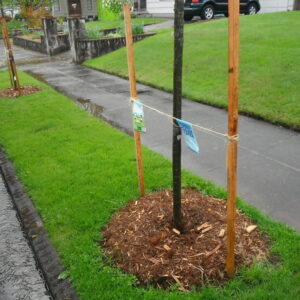
Roots can grow year round in the right conditions—moisture, air, and temperature—which is why we plant when we do, so trees can focus on establishing their roots. To help keep those conditions right for your young tree, make sure you replenish your mulch in the next couple months. One inch of mulch is a windbreaker, three inches is like a down jacket – and we want that year round, protecting against temperature extremes. Tree roots can grow 365 days a year as long as they have some moisture and a moderate soil temperature, both things that mulch provide.
This time of transition can be really exciting. It’s always remarkable to feel like summer is barely over, but by Halloween, which is now right around the corner, most of our trees will be dormant. As the seasons change, so do the needs of our young trees. So watch the weather, and stay tuned to Treemail for best practices for each season!
Leaflet
Restoring the Balance
Today, we’re asking you to put yourself in a tree’s shoes–or roots. Planting day is so exciting for volunteers. We get to hang out with our neighbors, get our hands dirty, and feel good about getting trees in the ground. But planting day is the most stressful day of a tree’s life.
When we plant a tree, we have to cut some of its roots. Container-grown trees need to have their roots cut to prevent them from circling in on themselves, even after they’re put in the ground. Ball and burlap trees are grown in the ground, but they also get their roots cut when they are put into that ball to be moved to their final location.

Trees are all about balance. Balance between canopy, where the tree can feed on sunlight and perform photosynthesis, and roots, which pull nutrients from the soil and provide the tree its needed strength and stability. For a newly planted tree, this time of year is all about restoring that balance and getting the roots and the shoots established.
Trees are like icebergs—there’s a lot more going on beneath the surface than we realize. Being able to understand what’s going on underground for our trees helps us better care for them, especially when it comes to watering.
We’ve mentioned watering plenty, but it’s so important that we can’t really talk about it too much. We have had an incredibly wet spring, which is great for the trees! As stewards, we’ve been able to keep our foot off the gas—we haven’t really had to worry about getting out our hose or watering bucket all that much.
But at some point the rain becomes intermittent and shallow enough that it doesn’t reach the tree roots. Watering trees is very different from watering grass, which benefits from frequent and shallow watering. One of the most common watering mistakes is watering your tree like you would your grass, for just a few minutes every day. For trees, we want deep and infrequent. In the summer, a thorough watering once a week is a perfect schedule (see details here).
When you water your tree, imagine what’s going on underground. We want to water the tips of the roots as they spread out. Another common watering mistake is when folks just point their hose at the base of the trunk and water there. You want to simulate a rain storm for your tree, watering all sides, and several feet away from the trunk so that you get the tips of the roots.
Overwatering is rare, but you still want to avoid it. Again, it helps to picture what’s going on beneath the surface. Perfect soil is about 50% air and water pockets. Too much water can flatten those pockets and there’s no air. You’re essentially drowning your roots. Beyond that, too wet soil threatens the stability of the tree. When a tree fails because it’s thrown by the wind, it’s usually because the soil is too wet.
This time of year, we are spectacularly rewarded for our care for our trees. Bud break, flowering, leafing out—it’s a rejuvenating thing to see each spring.
If you’re thinking about getting a new tree for your yard next year, now is a good time to consider which species you might want! What trees are catching your eye? What looks like it might be right at home in your yard. Take note now, and next year, we can get you what you’re looking for!

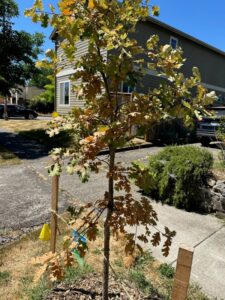

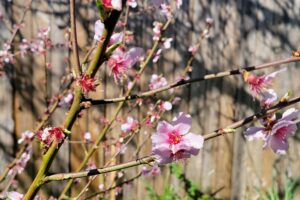
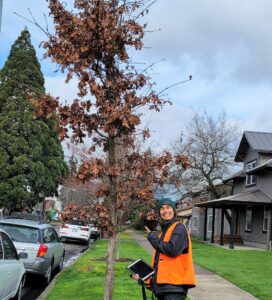 Go easy on the pruning
Go easy on the pruning